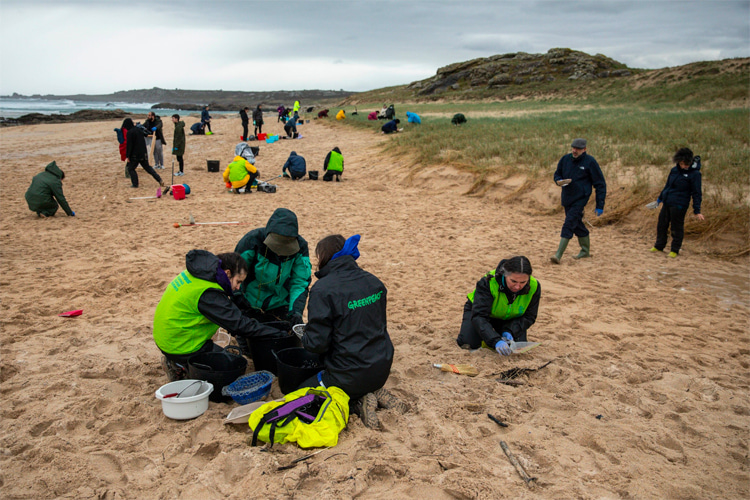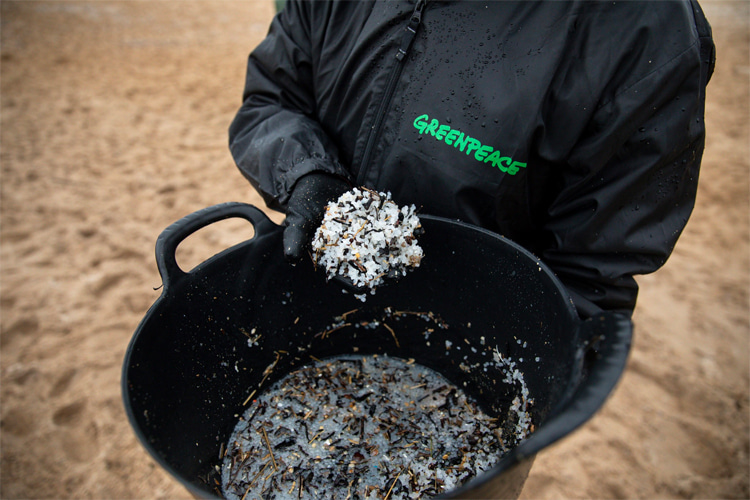Millions of tiny plastic pellets are washing up on the shores of northern Spain and Portugal after the merchant ship Toconao lost six containers in the Atlantic Ocean off the Iberian Peninsula.
The ship was on its way from Algeciras in the south of Spain to Rotterdam in the Netherlands. The event has been declared an environmental emergency by the Spanish authorities.
The environmental disaster is only compared to the 2002 Prestige oil spill. At the time, over 60,000 tonnes of heavy fuel oil were spilled along the Galicia coastline.
On December 3, 2023, Toconao, a container ship sailing under a Liberian flag and operated by Danish company Maersk, lost six shipping containers 50 miles (80 kilometers) off the coast of Viana do Castelo, Portugal.
One of these containers contained 1,000 sacks of pellets, also known as nurdles, with each raffia bag holding 25 kilograms of the tiny plastic balls.
The other containers carried tires, clingfilm, tomato sauce, metal components, and other goods.
Some pellet bags with the Polish-based company Bedeko Europe printed on them were washed up intact on the Galician coast, but others broke up and scattered millions of microplastics.
On December 13, hundreds of thousands of plastic pellets began washing up on Spain's Galicia coastline, from Vigo and Rías Baixas to Ferrol.
The same toxic balls were found on Portuguese and French beaches a few days later.
The "white tide" has particularly affected the area around Noia, a port town, but several coastal communities reported nurdles on their sands and shores.
At least 30 beaches have been identified with signs of pollution.

Plastic Pellets: Small and Non-Biodegradable
However, there are fears that the spill could spread east along the northern Spanish coast towards the Basque country.
According to Greenpeace and other environmental organizations, millions of pellets have been lost.
They will either wash ashore or be consumed by fish and birds and enter the human food chain.
These tiny environmental threats can easily break down into smaller microplastics and become impossible to track and collect.
Greenpeace, World Wildlife Fund (WWF), Friends of the Earth, SEO Birdlife, and Ecologists in Action issued a joint letter condemning the environmental tragedy.
"We ask that no partisan use is made of the catastrophe and that joint efforts are made to tackle the long-term impact of the spill, to determine responsibilities, and to reinforce the rules on the production, transport, and use of plastics," the letter said.
Volunteers and local workers started cleaning up the northwest beaches and coastline of Galicia, a region whose economy depends on the fishing industry.
Nevertheless, pellets are less than 5 mm wide and difficult to clean up.
Environmentalists are sieving water and combing through the sand to capture as many nurdles as possible.
The Galicia and Asturias regional governments issued level 2 alerts, meaning that additional resources and personnel will be allocated to address the environmental disaster.
The Spanish government has also activated logistical assistance to the affected areas.
However, the Galicia authorities accused the central government in Madrid of failing to inform them in time about the event and not activating a marine pollution plan.
Nurdles: An Environmental Disaster
In October 2023, two months before the disaster, the European Commission warned of the dangers posed by plastic pellets.
"Once in the environment, these small particles of plastics do not biodegrade and cannot be removed."
"They accumulate in animals, including fish and shellfish, and are consequently also consumed by humans in food."
"They contribute to the pollution with microplastics, which have been found in marine, freshwater, and terrestrial ecosystems as well as in food and drinking water."
White pellets are used to manufacture plastic products, including plastic bottles. They are made from non-biodegradable polyethylene terephthalate (PET) plastic.
Of 300 million tons of nurdles manufactured annually, 230,000 tonnes are believed to end up in the world's oceans.
In 2017, an estimated 2.25 billion nurdles spilled from a ship docked in Durban, South Africa.
Many ended up as far as Western Australia, 4,970 miles (8,000 kilometers) away.
Three years later, ten tonnes of pellets fell into the sea off the coast of Germany when a container on the MV Trans Carrier was damaged in a storm.
